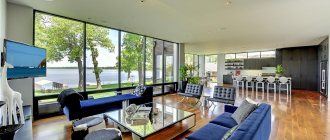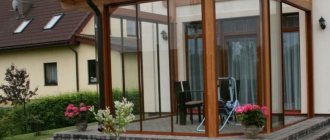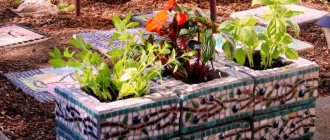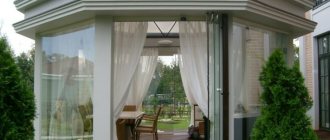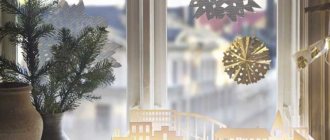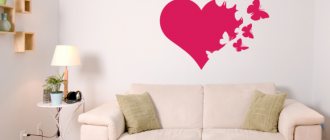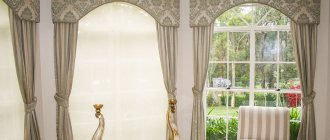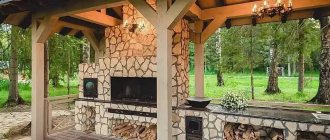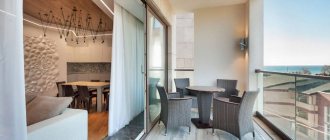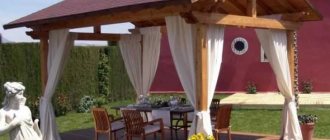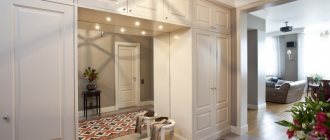Verandas are usually used in the warm season as additional usable space. Based on the type of construction, they are classified into attached and built-in. The first ones are built after the construction of the house is completed. The presence of built-in ones is provided for at the design stage of a residential building. Also, verandas can be with or without glazing. In the second case, the site is essentially a terrace equipped with a canopy. Verandas with glazing can be used not only in bad weather in the summer and without fear of rain or wind, which previously interfered with quiet gatherings, but also in the winter if they are heated. In this regard, the premises are similar to attics, into which cold attics are converted. In the south, the veranda is most often used as a gazebo or dining room. On the hottest nights, you can set up a bedroom here, where the coolness of the night comes in abundance. In the outback, equipment for a summer kitchen is moved here if there is no free separate building for these purposes. A veranda can be called not only an extension to a house, but also a separate room on the site in which a greenhouse or a hall for receiving guests (formerly for dance evenings) is equipped.
The fashion for such spacious “gazebos” came from France. And the word “veranda” itself is of Bengali origin, which in principle is not surprising if we recall the close ties of Old Europe with the countries of South Asia. Balconies and loggias, in fact, are also verandas, but they belong to city apartments in multi-storey buildings. Suffice it to remember that they are also divided into “warm” and “cold”. We will consider options for glazing verandas in private houses.
Features and Benefits
Glazing a veranda is that rare case when, among the many advantages, the disadvantages are lost. The room can be warm or cold. In the first case, it can be used in winter as a residential space. If the glazing is cold, then the temperature inside the veranda will be only a couple of degrees higher than the temperature outside, that is, the difference is insignificant. This veranda can only be used in summer. The advantages of glazing a room include:
- Protection from wind and rain (for both cold and warm options).
- Noise insulation.
- Possibility of arranging a separate room. In the case of cold glazing we are talking about a “summer residence”. With warm glazing, the room can be used all year round, that is, another full-fledged room is added to the living space on a “permanent basis”.
- Possibility of connecting to heating and using the room in winter (only for warm glazing). It is quite possible to arrange a bedroom, a small guest room, a winter garden, a storage room and a kitchen or dining room here. The choice of functional purpose depends entirely on the size of the veranda itself and its capabilities.
- Creating a stylish, unusual element of the interior and exterior of the house. Glazing can be different, and original solutions will emphasize the creativity of the design of the entire building as a whole.
If we mention the features of the glazing of the veranda, then it should fit well with the design of the house. This is a mandatory and most important condition. Next, you should pay attention to the area of the translucent sheet in order to provide it with proper support in the form of frames and at the same time not reduce the strength of the entire structure. The next stage is the choice of material for the frame, but we will talk about this in detail later. Modern glazing systems offer great opportunities for owners:
- Partial roof covering with sheets of heavy-duty glass.
- Exact repetition of the shape of the veranda.
- A variety of door and window opening systems.
- Adjusting the width and height of open door and window openings.
- Possibility of installing mosquito nets.
Now let's talk about the types of glazing, their disadvantages and advantages.
Features of glazing on the veranda and terrace
The veranda and terrace have some differences. The veranda is a part of the house that stands on the same level as the building itself. The veranda has a foundation, walls , window openings and a roof .
Veranda with glass roof
Cozy veranda with panoramic glazing
Advice! Since the veranda is part of the house, if there is heating in it, it makes sense to install warm glazing here, which will not only protect you from precipitation, insects and noise from the street, but also create an all-season recreation area.
If there is heating on the veranda, it makes sense to install warm glazing here
Warm glazing will not only protect you from precipitation, insects and noise from the street, but also create an all-season recreation area
A terrace is a separate building that can be adjacent to the house or stand apart. A terrace is considered an open area in the fresh air, which stands on a raised base and has only a roof on racks (sometimes the building has low railings).
Glazed terrace
A warm glazed terrace will allow you to have a pleasant time even in winter
Advice! For a terrace, warmth is not the most important condition, and therefore you can get by with cold, but bright and effective frameless glazing.
Terrace with bright and spectacular frameless glazing
A terrace with panoramic glazing will allow you to merge with nature, but at the same time be protected from its unpleasant surprises
Since quite often a terrace, like a veranda, is designed as an extension to a house, these concepts have long become practically synonymous.
Terrace and veranda have long become almost synonymous
Types of glazing
There are quite a few classifications of glazing depending on its features:
- Warm and cold, which were already mentioned above.
- Frameless and with frames.
- Full and partial.
- Swinging and sliding.
Panoramic glazing can be included in a separate category. Let's talk about each type in more detail.
Cold and warm
Cold glazing is used when the owners have chosen “seasonal use” for the veranda. Suitable basic materials:
- Plastic single-chamber double-glazed windows.
- Aluminum profile as a frame, which also weighs very little, unlike heavy wood.
- Panoramic windows.
Cold glazing looks stylish and practical. At the same time, double-glazed windows reliably protect the veranda from precipitation, dirt and dust. In summer, the room can be used as a study, relaxation room, summer kitchen, and in winter it can easily be converted into a pantry for storing pickles or “gifts from the garden.” Warm glazing is usually carried out using plastic double-glazed windows that have special air chambers.
They act as a “buffer”, trapping heat in the room and preventing cold from entering from the street. Window sashes fit hermetically to the frames. Glass consists of several transparent sheets, the spaces between which are filled with a special absorbent that absorbs moisture. Such glazing does not allow cold, moisture and wind to enter the room. It reliably protects the veranda from the external environment and allows you to convert it into a full-fledged living space. If we talk about cost, then you will have to pay more for double-glazed windows, but this option provides many more advantages.
Full and partial
Depending on the functional purpose of the veranda, its glazing can be full or partial. The first option allows you to create warm or cold glazing, that is, the openings are completely closed with double-glazed windows and there are no “gaping” windows left in the walls of the room. Partial glazing is a simpler and cheaper option. It is appropriate in cases where, for example, the room needs to be protected on the leeward side. This veranda can only be used in summer.
Frameless and with frames
Glazing with frames is a popular and already quite hackneyed option. Sheets of glass are placed inside a special frame, which provides the structure with strength and stability. Relatively recently (just a couple of decades ago), the fashion for frameless glazing came to us, when the facade consists entirely of sheets of heavy-duty glass, which are sealed at the joints. The illusion of a completely open space is created. Sheets of glass are fixed with aluminum profiles at the floor and ceiling. This option cannot be called budgetary, but relaxing on such a veranda will truly take your breath away. It is appropriate to use frameless glazing only in cases where the room offers a beautiful view (of a garden, field, meadow, nearby river or sea coast). Although the structure looks fragile from the outside, in fact it will outperform any other double-glazed window in terms of strength. For frameless glazing, only tempered glass is used, which is almost impossible to break.
If a blow of enormous force nevertheless damages the surface, then it will only be covered with small cracks, but will not shower everything around with fragments. The design is equipped with additional protection against accidental opening. The only disadvantages that can be noted are low noise insulation and difficulty in maintenance. In order for the glass to retain its transparency and “gloss,” they should not be washed with substances with an abrasive effect that leave small scratches on the surface. You will also have to forget about the old “grandmother’s” method using crumpled newspapers instead of a sponge.
Panoramic
Panoramic glazing is carried out along the entire facade, that is, the windows occupy the entire space from the ceiling to the floor. This is a stylish, original solution that originates in the European traditions of decorating windows facing the garden. The veranda will offer a magnificent view of the nearby beauty. Panoramic glazing can be frameless or with frames. This option is popular not only for verandas, but also for glazing balconies and loggias in high-rise buildings with a slight difference: there the system is necessarily supplemented with a protective frame that prevents a person from falling onto the glass.
The only disadvantages noted are the rapid fogging and freezing of the transparent fabric in winter.
To avoid this, you must either install an additional heat source in which hot air flows are directed at the windows, or regularly lubricate the glass with a glycerin solution.
Sliding and hinged
The swing opening system is familiar to everyone: window or door sashes, after turning the handle, open inward (usually 90 degrees). Plastic double-glazed windows use a more complex swing system, which additionally allows windows and doors to be partially opened from above by pulling them towards you. This option is ideal for ventilating the room. Hinged glazing provides good tightness. With its help you can create both a cold and warm room. The sliding system works on a completely different principle: the doors are moved to the sides on special guides located below and above. They can only “drive” in a straight line (as in sliding wardrobes) or fold “accordion-style”.
In the latter case, we are talking about panoramic glazing with frames, when large “window-doors” are compactly assembled against one of the walls of the veranda. Sliding systems cannot provide complete tightness, therefore they are used only for cold glazing.
Warm and cold glazing
1. Double-glazed window 2. Guides (rails) 3. Plastic frame profile 4. Plastic sash profile
Glazing using aluminum structures is called cold. This type of window is intended for rooms that are not heated in winter, i.e. for a terrace or veranda where people visit irregularly in winter. The temperature on the veranda with this option will be only 7-10 degrees higher than outside.
Advantages of cold glazing:
- light weight;
- long service life;
- ease of installation and maintenance.
Warm glazing is performed using double-glazed windows with a PVC profile and provides good thermal insulation.
It is suitable for an insulated veranda with heating. Advantages of warm windows:
- good noise and heat insulation;
- long service life;
- It is possible to install a mosquito net.
Most often, aluminum frames are made sliding or “accordion-style” to leave more free space on the veranda. Hinged structures or solid double-glazed windows are more appropriate for a warm terrace.
What is partial and full glazing
There are two types of glazing available:
- zonal;
- continuous.
Zonal glazing involves the presence of several windows with walls between them.
With a continuous or panoramic option, glazing occupies most of the three external walls.
Continuous glazing is sometimes “deaf”, i.e. dismantling without destroying the structure is impossible. A more “mobile” option: single frames that can be removed if desired.
Important! According to technical standards, with zonal glazing, the lower edge of the window should be at a height of 50-60 cm from the finished floor (not the foundation or ground level). With continuous glazing, adjacent frames must be separated by blind (non-removable) racks.
Construction materials
The glazing frame can be made of plastic, wood and aluminum. The materials are arranged by popularity, starting with the most popular. Of course, at first plastic began to be used everywhere in the glazing of city apartments. Gradually, it migrated to private homes, but wood and aluminum here continue to stubbornly hold their own. This is especially good for wood, which is involuntarily associated with the warm atmosphere of a country house and fits perfectly with the design in the chalet, country, and Provence styles that are so often used in the outback.
Aluminum
The main advantage of aluminum is its light weight. The material allows you to make the structure much lighter, but without compromising its strength. In terms of cost, aluminum also outperforms its main competitors. For comparison: the price of plastic glazing is twice as high as installing a similar aluminum structure. Unfortunately, the material did not become widely used due to its main drawback: the design retains heat very poorly.
A veranda with an aluminum profile can only be used in summer; in winter, it is most logical to install an “outdoor freezer” here. Although now manufacturers offer a rather expensive solution to this problem - thermal inserts and special liners that retain heat and create additional sound insulation. The aluminum profile is fireproof, so the risk of the structure igniting is reduced to zero, which becomes another advantage of the material when compared with wood.
Tree
Previously, only wood was used for glazing houses (not only verandas). With the advent of alternative options, this material began to be slowly forgotten, but its advantages did not fade. Wood has high noise and heat insulation. Although, of course, the glass itself receives the main “blow” in terms of heat conservation, a lot also depends on the frames. Unlike plastic or aluminum, wood does not need additional thermal liners, since the material itself prevents cold from entering the room and warm air from escaping outside. Wood has micropores, which allows it to “breathe”. Manufacturers of plastic double-glazed windows state in their characteristics that the maximum minus for the material is 30 degrees below zero. At this temperature, PVC loses strength and becomes brittle.
For wood, there is also a frost resistance limit, but this figure is so sky-high (minus 120 degrees) that even in the conditions of the Far North it is impossible to verify it. From this we can conclude: wood is the warmest material. The wood is environmentally friendly, but it will catch fire when in contact with an open flame. The material is pre-treated with special impregnations, which increase its fire resistance and moisture resistance. Contact with liquid is dangerous for wood. Material that is not properly processed can become deformed, rendering the double-glazed window completely unusable. And the main advantage of wood lies in its beauty, which neither aluminum nor PVC has. Warm, homely, “cozy” material will ideally highlight the design of an Alpine chalet, simple country, French Provence and rustic Russian style.
Plastic
Contrary to misconceptions, high-quality plastic does not emit harmful substances during operation. PVC retains heat perfectly, thanks to special rubberized inserts around the perimeter of the window and door sashes, the veranda remains airtight. Plastic windows provide good sound insulation. They are ideal for warm glazing, but are heavy, so they are not recommended for use in dilapidated dachas or old country houses. PVC cannot be called fire-resistant, but upon contact with an open flame, they do not catch fire, but begin to melt, releasing caustic substances.
Perhaps the main disadvantage of plastic glazing is its high cost. If you need to install one or two windows, then the purchase and installation will not hit the budget much, but for a panoramic double-glazed window you will have to spend a lot of money. Wood and aluminum leave PVC far behind in this regard, luring buyers with tempting prices.
To glaze the veranda you need:
Beautiful panoramic veranda
The veranda is glazed with thick frames from floor to ceiling. Photo of a beautifully glazed veranda...
Gazebo with glazing
Nice, cozy gazebo, glazed with wooden frames and windows. Report on the gazebo...
Glazing of the veranda with white frames.
Sequential photographs of work on glazing a country veranda.
From receiving ready-made veranda frames, then the process of painting and finishing, and to the completion of installation. The process of preparing and installing veranda frames. Photo report
Typical veranda at the dacha
Photo of the veranda of a country house.
A common option. All actions for glazing the veranda can be done independently, on your own. If you are familiar with installation work and have a tool, then this is not difficult to do. Carpentry workshop specialists will assemble all the necessary products and provide advice. Then the customer can install them. Also, if desired, installation work can be carried out by carpentry workshop masters.
Chetrezh, study of the future veranda
Drawing of veranda windows and doors with dimensions.
Where everything will be located and what kind of glazing will happen. To find out the cost, you can send your wishes and sizes by email or speak verbally to our specialists by phone. We will calculate and let you know.
Video on glazing a veranda painted white
Video on glazing a panoramic veranda
Glazing the veranda will decorate a country house and add a lot of positive emotions to the owners. This is a beautiful interior and facade of the building. This is a special style. This is a bright, airy room.
Installing windows on the veranda
The process of glazing the veranda.
Installation of windows and doors. The veranda is part of the house, a spacious room with a large glass area. A distinctive feature of the veranda is its airiness, lightness and the presence of many windows that provide a lot of light and transparency of the walls. The verandas have large window openings that are filled with various windows. Windows are made from various materials.
Wooden veranda - a veranda glazed with wooden veranda frames, window blocks and doors. For these purposes, many translucent structures are used, mainly with glazed verandas, which create a special style.
Wooden veranda at the dacha
Glazed wooden veranda at the dacha.
Finishing work. Veranda glazing allows you to make very large and tall windows. Also, these divisions inside the window reduce the wind load on the glass, which makes these windows safe. It can be noted that the veranda glazing that divides the glass is present only in wooden products. False linings are glued onto plastic windows directly onto a single glass unit, which create a veranda style. Special decorative films are glued to windows made of aluminum profiles, which allow you to visually create a certain pattern. Therefore, having set the goal of making a veranda, you need to immediately foresee what products you like.
Video on glazing a veranda with double-glazed windows
Wooden veranda windows, frames, and glazed blocks can be treated with various materials, giving the products even more style and uniqueness. The presence of special decorative paints and pigments allows you to create unique products that will create a special interior and facade. The paints create a vintage, antique look, the look of different metals and interesting materials.
Beautiful windows on the veranda
Beautiful white windows with a glazed veranda
A wooden veranda consists of wooden windows and doors and, as a rule, the inside is lined with wooden lining or a block house. When designing the future premises, we recommend making frames, blocks and veranda doors in the same style. We can also advise that the cells in the products be similar in size. This allows you to create a unified style.
Any glass can be installed for glazing. In the basic version this is 4 mm window glass. But they also install colored glass, bronze, with a pattern. Or even stained glass.
Prepared window openings on the veranda
A veranda made of profiled timber with prepared, cut-out window openings.
In suburban areas, country houses, and villages, many people are faced with the question of building a summer light structure in a beautiful place with the possibility of developing landscape design. They build gazebos among birch or pine trees, on the banks of rivers or in any other place. Having built a gazebo, after a while the question arises about its glazing. After all, rain, wind and fog sometimes make it difficult to sit quietly inside. Glazing in this case solves many issues.
Glass materials
The transparent canvas occupies the lion's share of the area of the glazed area, so its characteristics have a greater influence on the quality of the structure than the features of the frames and profiles. On verandas, not only “classic” glass is used, but also other materials that also ensure free penetration of sunlight into the room and at the same time protect from bad weather. Let's look at their varieties and evaluate the profitability of using them in veranda glazing.
Glass
For glazing houses, it is better to use special materials that have increased strength. All of them are produced in the form of sheets and belong to the large category of sheet glass. The following types are suitable for glazing the veranda:
- Tempered. Ordinary sheet glass undergoes special treatment: the mass is heated to high temperatures, followed by rapid cooling. The technology makes it possible to create strong glasses that can withstand heavy loads (compared to ordinary ones) and are absolutely safe for humans, since when hit hard they are showered with small fragments with blunt edges that cannot injure, even if the pieces fall on open areas of the skin.
- Laminated or triplex. Belongs to the group of tempered glasses with increased strength. Triplex is a layered “pie” of several sheets that are glued together. There are two types of such glass: cast and film. In the first case, gluing of sheets is carried out using a laminating liquid, and in the second - using a special film. When hit hard, triplex does not crumble like regular glass, but becomes covered with cracks sealed between two protective layers.
- Energy saving. A new product on the double-glazed window market, which so far only wealthy home owners can afford. Externally, glass is no different from ordinary sheet glass. It even has a standard thickness (no more than 1 cm), but from the inside its surface is covered with a special coating. It “repels” heat, redirecting it indoors, thereby preventing it from leaking out into the street.
- Stained glass. Glass is a decorative composition that is assembled from pieces of different colors enclosed in a metal profile. Previously, this option was widely used to decorate cathedrals and rich palaces in Europe. Real masters put together small pieces using the mosaic principle to create whole pictures that will become the highlight of the veranda interior. They have only one drawback - they do not transmit sunlight well, so they are often used in conjunction with ordinary transparent glasses and play the role of accent decor.
In addition to glass, there are several other transparent materials that are actively used for glazing verandas and gazebos on sites.
PVC film
PVC film is better known as “soft glass”. It is used only for cold glazing, since the material cannot cope with the vagaries of the domestic climate and harsh winter conditions. PVC film is sold in rolls and can have different thicknesses and colors. It is ideal as an alternative to expensive glazing due to its low cost. The material can be given any shape. Soft glass is often used as “flexible curtains”, which are rolled into compact rolls and secured in this position with ribbons. If it starts to rain or the wind rises, the curtains are lowered, but the street can be seen just as well as without them. The film is durable. With constant contact with sunlight, it can be used for up to five years. If operating conditions are more gentle, then this period is doubled.
Polycarbonate
Polycarbonate is often used for glazing greenhouses, summer greenhouses and gazebos. The material is flexible and light. It is classified into two types:
- Monolithic. The sheets are more like glass, transmit light well, and have high transparency.
- Cell phone. The sheets consist of two layers of material, which in cross-section are similar to “honeycombs”, that is, the surface of the polycarbonate is decorated with “stripes” formed due to the cells inside. The material transmits light well, but it cannot be classified as transparent. Suitable for verandas that need to be hidden from the view of passersby.
From an aesthetic point of view, monolithic polycarbonate looks more solid and noble. From a distance it is generally difficult to distinguish it from sheet glass. Cellular material benefits in cost, as it is more accessible. Naturally, such glazing is not suitable for warm verandas.
Materials used
Most often, the choice of the owners of country houses falls on the use of frames, although the appearance of frameless structures is truly amazing. Frame glazing of verandas and terraces involves the use of various materials, which have their own pros and cons:
- The use of wooden frames is a typical glazing of a veranda and terrace in a wooden house . You can make such frames yourself, or you can order modern wooden double-glazed windows, which are considered the most expensive designs among all materials. The main advantages of this material are its naturalness, as well as its long service life, high thermal insulation and the ability to replace individual parts. Among the disadvantages, the most often cited are the requirements for wood treatment against pests and fungi, as well as its “dislike” for humidity.
Glazing with a wooden frame has many advantages
- PVC or plastic glazing is the most popular option today. This type of glazing has many advantages: good thermal insulation, ease of maintenance and operation, a large selection of colors and models. Among the disadvantages, we can consider the relatively short service life (10-25 years), the heavy weight of the profile, for which a foundation is required, and the difficulty of doing it yourself .
PVC or plastic glazing is the most popular option today
Glazed terrace with plastic frame
Advice! There is an option to create a more durable structure using an additional metal frame - such windows are called metal-plastic. If necessary, the room can be provided with decent thermal insulation if you choose a design where there is an inert gas between the glass blocks.
Veranda with metal-plastic windows
- If the room is not heated, you can use glazing of the veranda and terrace with aluminum profiles. It is only suitable for cold glazing, which is the only limitation when using this material. The advantages of this method include high strength, light weight, long service life (about 80 years), environmental friendliness, and the ability to create structures of any shape, color and size.
Aluminum profile is only suitable for cold glazing
- A relatively new direction in glazing is the use of polycarbonate instead of glass. Glazing verandas and terraces with polycarbonate has a number of advantages: high thermal insulation properties, greater strength compared to glass, and lightness of the material.
A relatively new trend in glazing is the use of polycarbonate instead of glass.
Glazing verandas and terraces with polycarbonate has a number of advantages
Glazed terrace with mobile roof
Based on the method of opening windows, several glazing options are considered:
- casement glazing is the opening of the window sash towards you, familiar to everyone from childhood,
Veranda with hinged glazing
- sliding glazing of the veranda and terrace involves the “riding” of the sashes on rollers between the guides, and there are several options for such “riding” (the simplest design, like a wardrobe , the presence of additional fittings for the initial extension of the window sash from the integral structure, or the option when the sashes are sent to the corners where they “open” and fold like pages in a book),
Terrace with sliding glazing
Glazed terrace in a modern style
- “accordion” type glazing , when the sashes are folded like an accordion to the required distance.
Accordion type glazing
The glazed terrace looks very stylish
How to choose a glazing method
The choice of type of glazing for the veranda depends entirely on the functional purpose of the room. The first thing you need to decide is the time frame for its use:
- End of spring, summer, beginning of autumn.
- All year round.
You can already build on this when choosing the type of structure and materials. For “winter” verandas, durable wooden frames or plastic double-glazed windows, tempered glass or triplex are ideal. For cold glazing you can use aluminum, polycarbonate, and soft glass. Of course, a summer veranda will cost much less, but a “warm” one provides more opportunities.
Photo examples of decorating and decorating verandas and terraces in a country house
Before choosing a decoration method, you need to decide on the functional purpose of the room. There are several rules that are recommended to be followed when decorating a veranda:
- A large glazing area provides natural light, but can cause the room to overheat on a sunny day, so blinds or roller blinds are hung on the windows - they are easy to care for and use.
- You can also hang textile curtains on the open terrace, which will add visual lightness to the structure and protect from wind, dust or sudden rain.
- The main element of decor that is appropriate on a terrace or veranda is living plants. These can be flowerpots, compositions of several pots, hanging flowerpots and partitions with climbing plants.
- When designing an extension, you can provide for a fireplace that will warm you up in the evening or allow you to heat a closed space.
- It is recommended to choose furniture depending on the level of openness of the extension. In a warm room there are no restrictions, but in an open and unheated room it is better to install furniture made of artificial rattan, which is light in weight, has an aesthetic appearance and is not afraid of moisture.
- Upholstered furniture should have wear-resistant upholstery material that can be removed and washed when dirty.
- If a summer kitchen is installed on the terrace, then, in addition to the equipment, it is necessary to provide a rack for dishes.
- A common wall with the house can be decorated in any appropriate way - with the help of paintings, panels, hanging lamps.
The photo selection of beautiful verandas and terraces for the house, which is given below, will help you choose an idea and get inspired when choosing a way to design an extension.
Save time: selected articles delivered to your inbox every week
Design and decoration of terraces
The design of the veranda is selected to match the stylistic design of the house. The interior of this room should not stand out from the overall composition. Most often, verandas are used as a relaxation room. A wide sofa, armchairs, and a coffee table are placed here. The outside walls are covered with hops, grapes or ivy, and the windows are hung with light curtains. When the dimensions of the room allow, its interior is complemented with a couple of shelves with books and a cozy fireplace. If a loft is chosen as the main direction, then brick prevails in the decoration, and it is better to choose glazing with aluminum profiles. Similar designs are suitable for high-tech and modern style. Provence, modern, classic, chalet, and a number of ethnic styles are more impressed by wood. Plastic is universal and can be combined with any modern styles, but it is not suitable for luxury apartments, where every element of the interior should be associated with luxury.
Materials used
When choosing materials for the construction of glazed verandas or terraces, it is worthwhile to dwell in detail on the types of glass and additional elements for their fastening.
Glass
Glass is the main material used for glazing. It is used with various types of frames. But there are several alternatives that are more durable and functional.
Stained glass - it is based on full or partial tinting, as well as a drawing. Such glass is more expensive than regular glass, but can protect against direct sunlight.
Stained glass on the veranda
Tempered glass is used for frameless structures. According to its characteristics, it is able to withstand high mechanical loads, protects against climatic influences and has anti-vandal properties.
Energy-saving glass is used only with frames for warm options. They retain heat well inside and keep out the cold. Despite the high cost, this is the most effective material for insulating an extension.
Double-glazed windows are used in conjunction with plastic or aluminum profiles as frames. They have good sound insulation, which depends on the thickness of the glass unit, so they can be used in busy areas. Can be used for warm and cold glazing.
Plastic
Polycarbonate glass (another name for monolithic plastic, cast or plexiglass) is best used for creating round terraces, as it has plasticity. Additionally, an aluminum profile is used to create the frames. Wood is not suitable due to its lack of flexibility. Glazing a veranda with polycarbonate is a fairly cheap option and is often used in practice to save money, or to create cold verandas.
Polycarbonate for glazing can be of any color
Film
Currently, a special PVC film has been invented, thanks to which it has become possible to create “soft” windows. This film can be rolled into a roll with a fastening at the top. This material is quite dense and can be sealed tightly - it can be used in winter in heated rooms.
A well-installed and tensioned film is no different from glass
Despite its good properties, it is a rather fragile material that requires careful use. The disadvantage of these windows is that their width cannot be more than 140 cm. In this case, it is necessary either to use frames more often, or to choose the required length and fix them horizontally.
The nuances of self-glazing terraces
You can glaze the veranda yourself only if you plan to use wood as frames. You must first carefully take measurements and create design drawings. The glass is inserted into special grooves in the timber, which are cut out in advance. No matter how good a craftsman the owner is, his work will still be much inferior to ready-made double-glazed windows, which are produced in factories and undergo strict quality control.
Glazed veranda as a separate room in the house
When thinking about glazing a veranda, you should immediately understand what function it will perform. Here you can arrange a luxurious library, a separate office, a sunny playroom, a cozy living room, a spacious recreation area, a gym or another room. We'll tell you what you need to take care of even before construction begins, so that your veranda gives you only pleasant emotions.
Gaming
If you plan to use the veranda as a playroom, it needs to be insulated. Glazing must also be warm, especially in cold regions. During construction, it is recommended to use environmentally friendly natural materials, such as timber. It would be useful to provide a heated floor system. Strong tempered glass will increase the safety of panoramic glazing - they are not easy to break, but if this happens, the fragments will have rounded edges. Triplex is suitable as an alternative - if damaged, such glass cracks and remains on the film.
Living room
Warm glazing, installation of convectors and roof insulation will help make home gatherings on the veranda more comfortable. Soft sofas, textiles and rattan furniture will create a relaxed atmosphere. For glazing, it is recommended to use multifunctional glass, which will ensure a comfortable stay on the veranda, they will protect from the scorching sun, precipitation, dust and reduce heat loss.
Cabinet
A glassed-in veranda is an ideal place to organize a work area. Panoramic glazing allows you to enjoy the space and picturesque views while waiting for inspiration. To make your workspace more comfortable, you need to provide sun protection in the form of Roman shades, blinds or tinted glass. High-quality insulation will allow you to use the veranda-office all year round.
Relaxation area with barbecue
On the closed veranda you can organize a barbecue without fear of rain in summer or freezing cold in winter. When glazing the veranda, it is worth using multifunctional double-glazed windows, which will ensure the absence of condensation. Also discuss with the builders in advance or design the layout yourself, taking into account the fact that:
- the oven or grill for cooking meat should not interfere with movement around the extension;
- there must be a place for storing firewood;
- To remove smoke and food odors, you definitely need a powerful hood, and when using a stove, a chimney with good draft;
- The area for thermal processing of food and open fire must be finished with fire-resistant materials.
